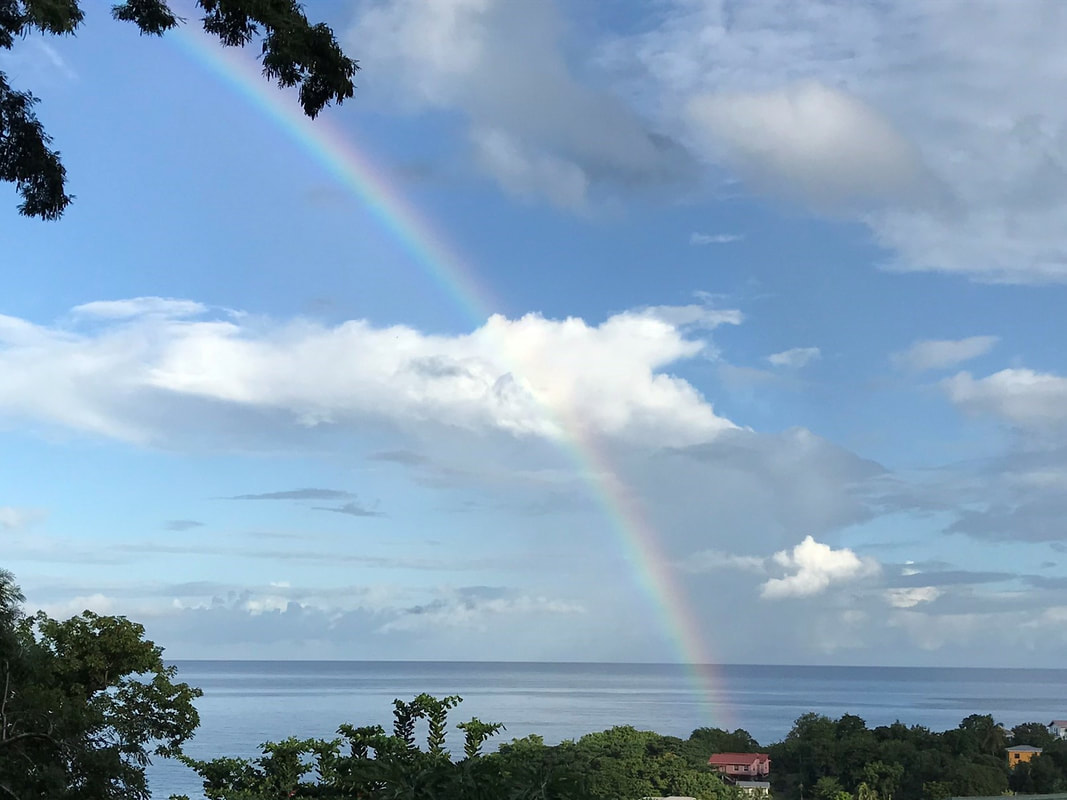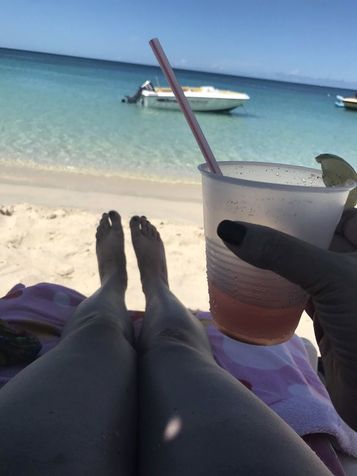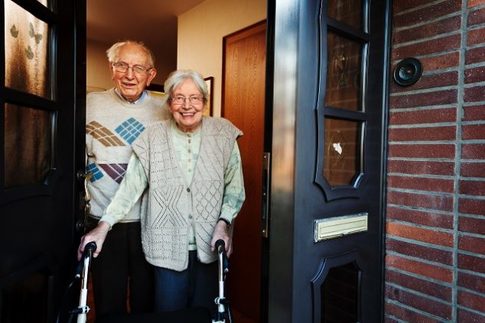|
Oil down is the national dish of Grenada with a long, interesting history. The name comes from the oil from the coconut milk and the meat juices that settle on the bottom of the pot when the dish is ready to eat.
The origin of the dish is during slavery when slaves from neighboring estates would get together to share a meal. This was not only a practical way of combining scarce resources but also a way to socialize. Each person would bring what they could salvage from the master’s larder, hence the varied ingredients. By each person contributing, each felt comfortable in sharing in the meal. In modern times, cooking oil down is usually a family or community event, much like our American BBQ. There are as many ways to cook oil down as there are families who cook them, but the basic ingredients are pretty much the same: breadfruit, coconut, salt meat or fish (these were brought by ships from Europe in previous centuries & constituted the main ingredient in the diet of seamen as well as the diet of slaves), dumplings, turmeric and callaloo. The latter is the only ingredient native to Grenada, used by the original Amerindian inhabitants of the island. Since I like to cook & try new recipes, I decided to cook oil down. The result will be recorded in my upcoming book “Caribbean Cooking Disasters”. I put too much water with the grated, fresh coconut, the requisite coconut milk was too thin. I put the callaloo in the bottom, so it became a sticky mess, I didn’t soak the salt pork long enough, well, you get the idea. But I learned & herewith is my own recipe for oil down: INGREDIENTS:
1 Comment
 The MV Berlin The MV Berlin I did not see an ocean or sea until the summer before my 17th birthday. It was not an auspicious introduction. We had boarded the MS. Berlin, a passenger liner which had regularly ferried people between the Old World and the New. Though by today’s standards she would be subpar, for 1958, she was luxurious. Once all luggage was stowed, cabin assignments sorted out, on board rules & regulations explained, drawings of the various parts of the ship, stores, eating facilities, library, bars, swimming pool, etc, I immediately went below to our cabin & lay down. I don’t now remember where the rest of my family members were, but I was the only one in our cabin. After about 15 minutes, a knock came & one of the ship’s officers told me to get up & get on deck, no matter how terrible I felt. He assured me that if I did not do this, I would spend the rest of the crossing in my bed. I heeded his advice & the scene on deck was not pretty. Many were leaning over the railing, doing what my mother called “feeding the fish”. However, the officer turned out to be right & the nausea slowly subsided & as the clouds cleared & the sky brightened, I felt much better. I could now marvel at the vastness of the sea, the gulls that followed us, the hum of the engines & all was well with the world. The passage took 12 days with a stop in Halifax, Nova Scotia. On-board life was wonderful, with any number of activities, shuffle board, swimming, dancing at night, lounging in the cool sun on deck chairs, with drinks being served by stewards. There was one other storm to weather but by then I had my sea legs & could only be amused by the storm’s effect. I was swimming & suddenly all the water sloshed out of the pool, overflowing the surrounding tiles & I was on my stomach in an empty pool. The arrival in New York was suitably impressive with Lady Liberty on guard. We settled in Chicago & it was another 7 years before I saw the sea again. For my second encounter it was the Pacific Ocean in Acapulco, Mexico where a friend & I had gone on vacation. This sea was magnificent with deep colors, a white, sand beach & a great variety of sea birds to watch. Swimming was so easy, the salt water so much more buoyant, the water warm, compared to Lake Michigan waters. I couldn’t get enough of it. The next year, another friend & I went to Mexico again, this time to Puerto Vallarta, which then was just a sleepy village with 2 hotels. By now I was truly in love with the sea. Two years after this trip, in 1968, I went on a Windjammer cruise to the West Indies & saw the Atlantic as well as the Caribbean Sea. It was pure magic, with snorkeling over pristine coral reefs, lazing on powdery white beaches & I was hooked for life. In 1971 I returned to the West Indies, where my then husband & I ran a large sailing passenger boat for 8 months until it was sold. Our cruises went from the south, the Grenada Grenadines to north, the St. Vincent Grenadines. The seas were kind, the colors magnificent. My crew worked hard to allow me the most time to swim & snorkel, we had lobster every week, life was grand. While negotiations were going on to sell the boat, we were anchored in Trinidad, the Gulf of Paria, with Venezuela visible on clear days. After she was sold, we went to England & I met a very different sea. The North Sea is dramatic, restless, cold, temperamental but awe inspiring to watch. Swimming was a shock to me after the warm waters of Mexico & the West Indies, but that was not the only North Sea experience. My then husband & I bought a coasting freighter to carry general cargo to the Scandinavian countries, Poland, Holland, Belgium & England. We did this for the better part of 9 months. The North Sea demands great respect. It can be the roughest, most frightening monster or it can be a marvel of nature, from pancake ice in the Norwegian Fjords to the placid green of the open stretches to the northern lights. When rough, you just hope to either die on the spot or pray for stepping ashore the soonest possible. I remember one particularly bad storm, sitting in my cabin, watching through the port hole, the violent peaks and valleys created by the powerful waves; the pitching of our vessel, making a mockery of the horizon line. And yet, I loved this awesome sea. And so, in 2013, we retired & chose Grenada as our permanent home. I now look out at the Caribbean Sea from my house. She is placid, but never the same on any given day. I sit & watch her moods through all seasons & she soothes my soul. Several times a week I go swimming. The water carries me, caresses me, restores me. The beach is ideal for a long walk, people watching, watching boats of all kinds come & go. I look at the tourists & think, they pay thousands of dollars for this & it’s mine any day of the week. I never lose sight of the fact that I’m very fortunate. The sea is my restorative medicine; my friend for the rest of my life. 1 cup of fresh lime juice
2 cups of grenadine syrup 2 cups of Caribbean rum 1 cup of coconut rum 2 cups of pineapple juice 2 cups of orange juice 5-8 drops of Angostura bitters A dash of nutmeg Orange, lime and/or pineapple slices for garnish. Mix ingredients together and be sure to add crushed ice or ice cubes before serving. By Home Advisor
As we age, we strive to keep the independence we gained throughout our lives. This is no easy task. Bodies become worn and weakening from years of use. Our brains are full of a lifetime of experiences and information, causing our cognitive functions to slow. Illness and injury, be it temporary or terminal, seem to find us more often than others. Fortunately, for most of us, the same ambition that drove us toward independence as children will drive us to keep it as long as possible into and throughout our senior years. Whatever your motivation–whether you’re recovering from your first age-related injury in the hospital or more of your friends have moved into assisted living homes–staying at home can make the transition into twilight years easier. Common Illnesses & Injuries Affecting Seniors As we age, our ability to care for ourselves begins to diminish. This happens slowly at first, and you may start to notice that bruises last longer, or small cuts take longer to heal. These issues become more pronounced and frequent as we get older. There are a number of common conditions that affect seniors, such as:
Preventing In-Home Injuries For seniors to keep their independence, they must have a safe environment to live in. Safe is a relative term that must factor in a person’s individual needs. Understanding your health, medical conditions and any complications that may arise is the first step to staying in your own home. Not making the necessary modifications in preparation for the progression of your condition and age can worsen physical pain and lead to permanent injury or even death. Falls Falls are the leading fatal injury among seniors. Around 3 million seniors are hospitalized each year due to a fall. Fall-related injuries can range from minor to severe. They include hip, pelvis, or vertebrae fractures, which often require major surgery to repair. This can lead to permanent disability and financial instability. Costs for treating falls and fall-related injuries in seniors is estimated to be near $70 billion annually. Any injury that leads to lengthy or complicated, rehabilitation can prevent you from living independently. The recovery process following a severe fall can lead to depression as well as a complete loss of physical and financial independence, making fall prevention an important consideration for all seniors. Traumatic brain injury (TBI) or other head trauma sustained during a fall can also have long-term consequences from which a senior may never recover. Regular exercise under the care of a physician or physical therapist along with vitamin D supplements will strengthen the body, increase stability, and help prevent falls. If mobility is a major issue, changing your home to reduce fall hazards is also a good idea. Changes to consider include:
Burns Burns are very common among seniors—the second leading cause of death from home injuries. Older adults do not respond as well to burn treatments and experience a much higher mortality rate as a result. This makes burn prevention a critical issue. Individuals with balance, vision, or memory issues are more likely to burn themselves accidentally or start a fire. Conditions such as peripheral neuropathy dramatically increase the chances of a person experiencing a severe burn. Peripheral neuropathy affects how and when sufferers feel pain and can occur from physical injury, cancer, diabetes, infection, some medications, diseases and environmental factors. To help prevent burns and the potential for a fire, consider:
Additional Considerations Burns and falls are not mutually exclusive. In fact, they often occur together or with other injuries. Taking time to understand the consequences of sustaining an in-home injury will guide you in taking the right preventative measures. This may seem daunting at first. However, preparing your home to age in place while you have the time and resources will help you keep your independence longer. For more information about related topics, please visit www.homeadvisor.com. |
AuthorHi I'm Maria Davies. On this blog I share my life in the Caribbean as well as my passion for mentoring, food, travel and fitness. Enjoy! Archives
April 2024
|




 RSS Feed
RSS Feed